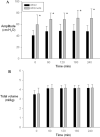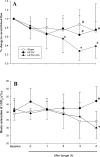Hemodynamic effects of high frequency oscillatory ventilation with volume guarantee in a piglet model of respiratory distress syndrome
- PMID: 33592023
- PMCID: PMC7886162
- DOI: 10.1371/journal.pone.0246996
Hemodynamic effects of high frequency oscillatory ventilation with volume guarantee in a piglet model of respiratory distress syndrome
Abstract
Respiratory failure is a common condition faced by critically ill neonates with respiratory distress syndrome (RDS). High frequency oscillatory ventilation (HFOV) is often used for neonates with refractory respiratory failure related to RDS. Volume guarantee (VG) mode has been added to some HFOV ventilators for providing consistent tidal volume. We sought to examine the impact of adding the VG mode during HFOV on systemic and cerebral hemodynamics, which has not been studied to date. A neonatal piglet model of moderate to severe RDS was induced by saline lavage. Piglets (full term, age 1-3 days, weight 1.5-2.4 kg) were randomized to have RDS induced and receive either HFOV or HFOV+VG (n = 8/group) or sham-operation (n = 6) without RDS. Cardiac function measured by a Millar® catheter placed in the left ventricle as well as systemic and carotid hemodynamic and oxygen tissue saturation parameters were collected over 240 min of ventilation. Mean airway pressure, alveolar-arterial oxygen difference and left ventricular cardiac index of piglets on HFOV vs. HFOV+VG were not significantly different during the experimental period. Right common carotid artery flow index by in-situ ultrasonic flow measurement and cerebral tissue oxygen saturation (near-infrared spectroscopy) significantly decreased in HFOV+VG at 240 min compared to HFOV (14 vs. 31 ml/kg/min, and 30% vs. 43%, respectively; p<0.05). There were no significant differences in lung, brain and heart tissue markers of oxidative stress, ischemia and inflammation. HFOV+VG compared to HFOV was associated with similar left ventricular function, however HFOV+VG had a negative effect on cerebral blood flow and oxygenation.
Conflict of interest statement
The authors have declared that no competing interests exist.
Figures






Similar articles
-
Impact on cerebral hemodynamics of the use of volume guarantee combined with high frequency oscillatory ventilation in a neonatal animal respiratory distress model.Eur J Pediatr. 2024 Jan;183(1):157-167. doi: 10.1007/s00431-023-05245-0. Epub 2023 Oct 18. Eur J Pediatr. 2024. PMID: 37851085
-
Effects of high-frequency oscillatory ventilation on circulation in neonates with pulmonary interstitial emphysema or RDS.Intensive Care Med. 1997 Jun;23(6):671-6. doi: 10.1007/s001340050392. Intensive Care Med. 1997. PMID: 9255648
-
Effect of the I/E ratio on CO2 removal during high-frequency oscillatory ventilation with volume guarantee in a neonatal animal model of RDS.Eur J Pediatr. 2016 Oct;175(10):1343-51. doi: 10.1007/s00431-016-2770-2. Epub 2016 Sep 5. Eur J Pediatr. 2016. PMID: 27595847
-
[Effects of high-frequency volume-guaranteed ventilation in preterm newborns with respiratory distress syndrome: exploratory review].Andes Pediatr. 2024 Aug;95(4):449-458. doi: 10.32641/andespediatr.v95i4.4892. Andes Pediatr. 2024. PMID: 39760603 Review. Spanish.
-
New Ventilator Strategies: High-Frequency Oscillatory Ventilation Combined with Volume Guarantee.Am J Perinatol. 2018 May;35(6):545-548. doi: 10.1055/s-0038-1637763. Epub 2018 Apr 25. Am J Perinatol. 2018. PMID: 29694993 Review.
Cited by
-
[Efficacy of volume-guaranteed high-frequency oscillatory ventilation in preterm infants with respiratory distress syndrome and its impact on cerebral blood flow in the middle cerebral artery].Zhongguo Dang Dai Er Ke Za Zhi. 2025 Mar 15;27(3):286-292. doi: 10.7499/j.issn.1008-8830.2409030. Zhongguo Dang Dai Er Ke Za Zhi. 2025. PMID: 40105073 Free PMC article. Chinese.
-
Impact on cerebral hemodynamics of the use of volume guarantee combined with high frequency oscillatory ventilation in a neonatal animal respiratory distress model.Eur J Pediatr. 2024 Jan;183(1):157-167. doi: 10.1007/s00431-023-05245-0. Epub 2023 Oct 18. Eur J Pediatr. 2024. PMID: 37851085
-
High-frequency oscillatory ventilation with volume guarantee in infants: a systematic review.Pediatr Res. 2025 Mar 20. doi: 10.1038/s41390-025-03934-0. Online ahead of print. Pediatr Res. 2025. PMID: 40113997
References
-
- Gleason CA, Devaskar SU. Avery’s Diseases of the Newborn 9th ed Philadelphia: Elsevier Saunders; 2012.
Publication types
MeSH terms
Grants and funding
LinkOut - more resources
Full Text Sources
Other Literature Sources

